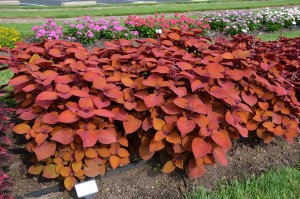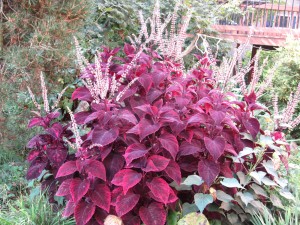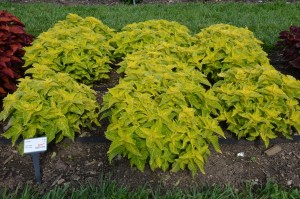Coleus (Plectranthus scutellariodes) is a summer annual treasured for its colorful foliage. Plants thrive in summer’s heat and humidity (USDA hardiness zone 11). Coleus is a member of the nettle family Lamiaceae. You can create dazzling beds of color using coleus alone or mixed with flowering annuals.
Modern day coleus grow more compact and better branched. Trailing forms add another option. Every year new varieties surpass previous color barriers. The color array includes green, pink, yellow, orange, red, purple (almost black), cream, and white. Choose from solids, blended colors, or color-veined foliage.
Most varieties perform best in morning sun and afternoon shade, although shade only types are available. Cultivar series such as the ColorBlaze®, Wizard Sun®, Main Street®, and Ducksfoot® prefer partial to full sun, while the Mosaic® and Kong® series excel in moderate shade. ‘Fish Net Stockings’ struts lime green leaves with dark purple venation.
In northern climes (zones 7 and north), coleus prefers moist, compost-rich soil. Excesses or deficits in soil moisture should be avoided. Plant coleus after the spring frost threat has passed and soil temperatures have warmed above 50 ºF. Light feeding with a water soluble fertilizer such as Miracle-Gro™, Peters™, or Schultz™ every 6 -8 weeks is recommended. For containers incorporate a slow release fertilizer or feed with water soluble fertilizer.
Spacing between plants differs with cultivar size and vigor and this information is usually printed on the plant tag. In general midsize and trailing cultivars should be 16-18 inches apart. Large shade types cultivars should be spaced 24 inches apart unless they’re routinely pinched back.
Over the first 4-5 weeks newly set plants benefit by pinching (light tip pruning) to increase branching and plant density. New coleus cuttings may be quickly rooted from pinched shoots. After 3-4 weeks you can plant rooted cuttings into new garden areas.
Many gardeners opt to pinch off the small flowers to channel energy into plant growth and enhance leaf color and size. Some new cultivars exhibit delayed flower formation.
Scale, spider mites, mealybugs, whiteflies and aphids are occasional pests on coleus.




 Posted in
Posted in 
